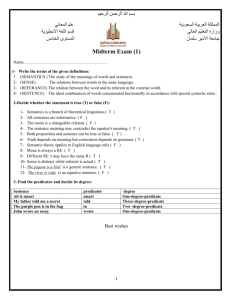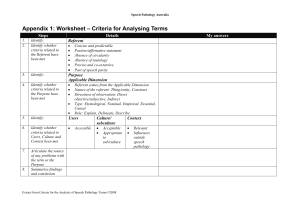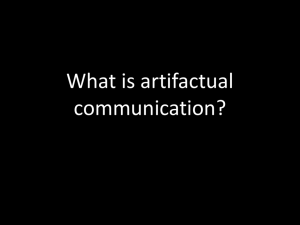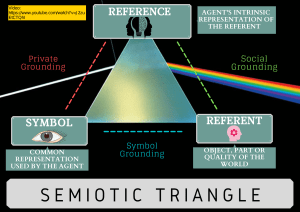Syntax & Semantics in Chinese History: A Linguistic Analysis
advertisement
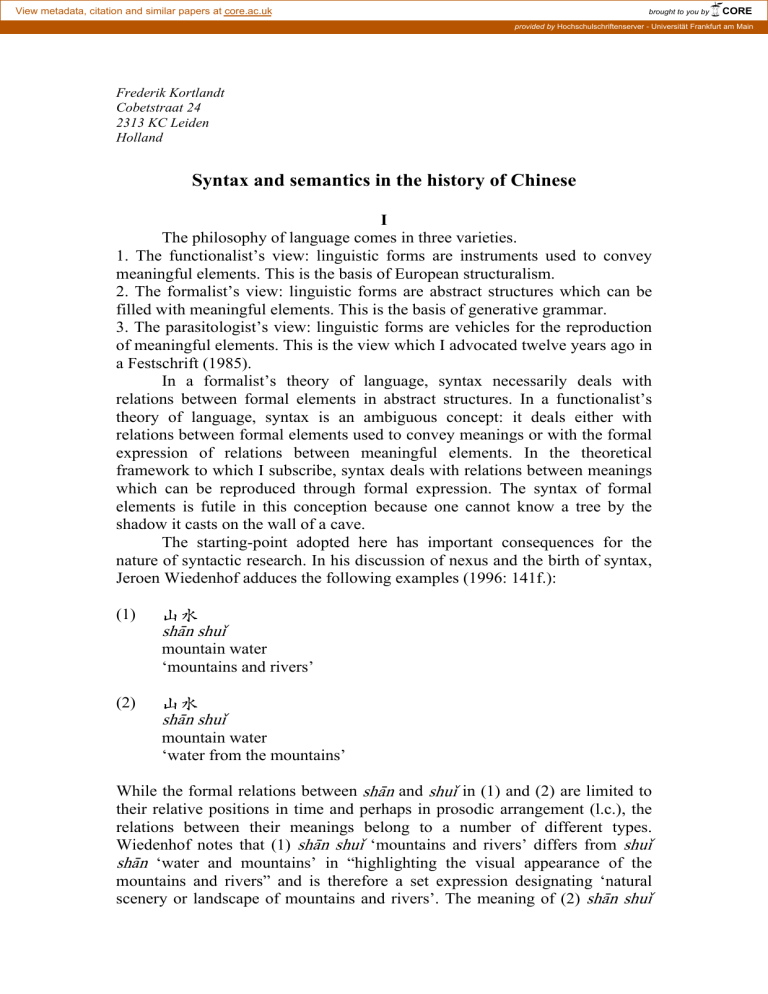
View metadata, citation and similar papers at core.ac.uk brought to you by CORE provided by Hochschulschriftenserver - Universität Frankfurt am Main Frederik Kortlandt Cobetstraat 24 2313 KC Leiden Holland Syntax and semantics in the history of Chinese I The philosophy of language comes in three varieties. 1. The functionalist’s view: linguistic forms are instruments used to convey meaningful elements. This is the basis of European structuralism. 2. The formalist’s view: linguistic forms are abstract structures which can be filled with meaningful elements. This is the basis of generative grammar. 3. The parasitologist’s view: linguistic forms are vehicles for the reproduction of meaningful elements. This is the view which I advocated twelve years ago in a Festschrift (1985). In a formalist’s theory of language, syntax necessarily deals with relations between formal elements in abstract structures. In a functionalist’s theory of language, syntax is an ambiguous concept: it deals either with relations between formal elements used to convey meanings or with the formal expression of relations between meaningful elements. In the theoretical framework to which I subscribe, syntax deals with relations between meanings which can be reproduced through formal expression. The syntax of formal elements is futile in this conception because one cannot know a tree by the shadow it casts on the wall of a cave. The starting-point adopted here has important consequences for the nature of syntactic research. In his discussion of nexus and the birth of syntax, Jeroen Wiedenhof adduces the following examples (1996: 141f.): (1) (2) shän shuî mountain water ‘mountains and rivers’ shän shuî mountain water ‘water from the mountains’ While the formal relations between shän and shuî in (1) and (2) are limited to their relative positions in time and perhaps in prosodic arrangement (l.c.), the relations between their meanings belong to a number of different types. Wiedenhof notes that (1) shän shuî ‘mountains and rivers’ differs from shuî shän ‘water and mountains’ in “highlighting the visual appearance of the mountains and rivers” and is therefore a set expression designating ‘natural scenery or landscape of mountains and rivers’. The meaning of (2) shän shuî ‘water from the mountains’ is again quite different because the expression “refers to water, not to mountains” (Wiedenhof, l.c.). Here the referent of shän ‘mountains’ differs from the referent of shuî ‘water’ but distinguishes the latter from those referents of shuî ‘water’ which are not referents of shän shuî ‘water from the mountains’. Thus, we arrive at three different meanings of shän shuî: (1a) (1b) (2a) There is an entity X which consists of P and Q; P is the referent of shän and Q is the referent of shuî. There is an entity X of which P and Q are visible parts; P is the referent of shän and Q is the referent of shuî. There is an entity X which is identical with Q and qualified by P; Q is the referent of shuî and P is a virtual (imagined) referent of shän. As Wiedenhof points out, the latter meaning “represents a conceptual advancement”: syntax “provides a means to apply existing signs to new ends” (l.c.). Consider now the following examples: (3) gäo shän high mountain ‘high mountains’ (4) shän gäo mountain high ‘the mountain is high’ The relation between the meanings of gäo and shän in (3) gäo shän ‘high mountains’ differs from the relation between those of shän and shuî in (2) shän shuî ‘water from the mountains’ in two respects. Firstly, the property of being high is carried by the same referent as the property of being a mountain. Secondly, the property of being high presupposes the property of being a mountain in the referent. Thus, we arrive at the following meaning: (3a) There is an entity X which is identical with Q and qualified by P; Q is the referent of shän and P is the (set of) feature(s) gäo carried by Q. The virtual referent P of shän in (2a) is replaced by the abstraction P of gäo in (3a). The latter meaning is more complex because the height of the mountains in (3) gäo shän ‘high mountains’ does not exist without the mountains whereas the mountains in (2) shän shuî ‘water from the mountains’ can exist without the water. The meaning of (4) shän gäo ‘the mountain is high’ differs from that of (3) gäo shän ‘high mountains’ in the presence of a temporal dimension (cf. Wiedenhof 1996: 146). Apart from the mountain which is high, the 2 expression (4) shän gäo conjures up in the mind the thought of a situation where the mountain is high (cf. Ebeling 1978: 231). The meaning can therefore be described as follows: (4a) There is a situation E where P carries the (set of) feature(s) Q; P is the referent of shän and Q is the (set of) feature(s) gäo. A situation can be defined as an entity with a temporal dimension. Finally, we have to consider the following example (cf. Wiedenhof 1996: 147): (5) gäo high ‘it is high’ The meaning of (5) gäo differs from that of (4) shän gäo in the absence of the mountain: (5a) There is a situation E where an entity X carries the (set of) feature(s) gäo. II Against the background of the theoretical framework outlined here I would now like to reconsider Chaofen Sun’s analysis of grammaticalization in the history of Chinese. Sun adduces the following examples illustrating the development of bâ from a full-fledged lexical verb meaning ‘to hold’ through a preverbal object marker into a grammaticalized preposition marking high transitivity (1996: 59-75). (6) (6a) (7) (7a) (8) zuó-shôu bâ qí xiù left-hand hold his sleeve ‘the left hand holds his sleeve’ There is a situation E where P is holding Q; P is the referent of zuó-shôu and Q is the referent of qí xiù. zuì bâ huä kàn yì zì shäng drunk hold flower watch more self hurt ‘drunk, I look at the flower by holding it, even more broken-hearted’ There is a situation E where an entity X [...] is holding P and looking at Q [...]; P is the referent of huä and Q is identical with P. mò bâ hángzhöu cìshî qï 3 (8a) NEG BA Hángzhöu magistrate deceive ‘do not deceive the magistrate of Hangzhou’ There never is a situation E where an entity X deceives P; P is the referent of hángzhöu cìshî. In the latter example the meaning ‘to hold’ has been lost. The development of the bâ construction is correlated with the history of the Chinese passive marker bèi, which developed from a full verb meaning ‘to receive’. (9) (9a) bèi shuî hán zhï hài receive water cold REL damage ‘receive damage from flood and cold’ There is a situation E where an entity X receives the (set of) feature(s) Q, viz. X being damaged by P; P is the referent of shuî hán and Q is the referent of hài. (10) cháng bèi lâo yuán töu gé-lÙ often PASS old Yuán steal rhyme-scheme ‘my prosodic scheme was frequently stolen by Old Yuán’ (10a) There is often a situation E where an entity X is affected by P stealing Q; P is the referent of lâo yuán and Q is the referent of gé-lÙ. (11) dú zuò táng shàng, yè bèi cì-sî alone sit hall up, night PASS stab-die ‘sitting alone in the hall, he was stabbed to death at night’ (11a) There is at night a situation E where an entity X [...] is stabbed and dies. (12) bèi huô shäo-sî PASS fire burn-die ‘he was burned to death by fire’ (12a) There is a situation E where an entity X is burned by P and dies; P is the referent of huô. In (9) the subject of the event receives the damage as if it were an object; in (10) he is affected by an event in which he is neither the actor nor the object; in (11) and (12) he is the object of the event. While bèi turned into an actor marker, bâ developed into a preverbal object marker: (13) ruò bâ bái-yï qïngyì tuö 4 if BA white-clothes easy undress ‘if one takes off the white dress easily’ (13a) If there is a situation E where an entity X takes off P with ease; P is the referent of bái-yï. (14) bâ tä tángyìn jiäng qù BA his seal take go ‘take away his seal’ (14a) There is a situation E where an entity X takes P and goes; P is the referent of tä tángyìn. This development leads to the full grammaticalization of bâ in modern Mandarin: (15) wó bâ nèi-bên shü gêi le tä me BA DEM-CL book give PFV him ‘I gave him the book’ (15a) There is a situation E where I carry the (set of) feature(s) Q, viz. having given P to him; P is the referent of nèi-bên shü and Q is the referent of gêi le. Here bâ has lost its verbal character, as is clear from the fact that it cannot replace the verb ná ‘to take’ in the following sentence: (16) wô ná le yi-bên shü me take PFV one-CL book ‘I took a book’ (16a) There is a situation E where I carry the (set of) feature(s) P, viz. having taken Q; P is the referent of ná le and Q is the referent of yi-bên shü. (17) wô ná nèi-bên shü gêi le tä me take DEM-CL book give PFV him ‘I gave him the book’ (17a) There is a situation E where I carry the (sets of) features P and R, viz. taking Q and having given it to him; P is the referent of ná, Q is the referent of nèi-bên shü, and R is the referent of gêi le. While ná has the valences ‘taking’ and ‘taken’, bâ has the valences ‘having an object’ and ‘being an object’. The essential point is that there is no direct syntactic relation between wô and bâ in example (15), where the first valence of bâ is filled by ‘giving’ and the second by ‘book’. 5 In conclusion, bâ developed from a full-fledged lexical verb through a serial verb construction into a grammaticalized marker of high transitivity. The development involves the following reanalysis of the bâ N V sequence: 1. There is a situation E where an entity X holds N. 2. There is a situation E where an entity X holds N and carries the (set of) feature(s) V which may affect N. 3. There is a situation E where an entity X carries the (set of) feature(s) V which affect N. The temporal dimension of the situation E shifts from X holding N to X carrying the (set of) feature(s) V and is lost in bâ, which thereby loses its verbal character. III Sun derives the suffixal aspect marker le ‘perfective’ from the verb liâo ‘to complete’ and the sentential clitic expressing perfect aspect le ‘currently relevant state’ from the verb lái ‘to come’ (1996: 82-103). Consider the following examples: (18) wô chï le fàn le me eat PFV food CRS ‘I have eaten’ (18a) There is a situation E resulting from a prior situation F where I carry the (set of) feature(s) P, viz. having eaten Q; P is the referent of chï le and Q is the referent of fàn. (19) chï fàn le eat food CRS ‘I ate’ (19a) There is a situation E resulting from a prior situation F where an entity X carries the (set of) feature(s) P, viz. eating Q; P is the referent of chï and Q is the referent of fàn. (20) wô bu chï fàn le me NEG eat food CRS ‘I will not eat (now)’ (20a) There is a situation E resulting from a prior (imagined) situation F where I do not carry the (set of) feature(s) P, viz. eating Q; P is the referent of chï and Q is the referent of fàn. It is difficult to omit the sentential clitic in example (18) because this would suggest the absence of a currently relevant situation resulting from the event which is denoted by chï le fàn ‘(someone) ate’, so that “the sentence does not sound like a completed statement” (Sun 1996: 84). This can be remedied by 6 adding an anchor which renders the situation resulting from the prior event currently relevant: (21) wô chï le fàn qù me eat PFV food go ‘I will eat before going’ (21a) There is a situation E where I carry the (sets of) features P and R, viz. having eaten Q and going; P is the referent of chï le, Q is the referent of fàn, and R is the referent of qù. In the sentences (15) and (17) cited above the anchor is provided by tä having the book and in sentence (16) by shü being in my possession. In the following examples there is no such anchor. It follows from the analysis that (23) ??wô chï le fàn sounds worse than (22) ?chï le fàn as a statement (cf. Sun 1996: 83, 89). (22) chï le fàn eat PFV food (22a) There is a situation E with an entity X carrying the (set of) feature(s) P, viz. having eaten Q; P is the referent of chï le and Q is the referent of fàn. (23) wô chï le fàn me eat PFV food (23a) There is a situation E with me carrying the (set of) feature(s) P, viz. having eaten Q; P is the referent of chï le and Q is the referent of fàn. As in the case of bâ, the temporal dimension shifted away from the verb ‘to complete’ and the direct syntactic relation with the original actor was lost. The resulting monovalent atemporal meaning ‘completed’ of the suffix le is carried by the referent of the (set of) feature(s) denoted by the preceding verb, e.g. chï le, where the eating is finished. Sun argues that the sentential clitic le ‘currently relevant state’ (cf. Li & Thompson 1981: 238-300) partly represents earlier le ye, with le from liâo ‘to complete’ and ye being an earlier perfect marker: (24) chï fàn liâo ye eat food complete CRS ‘(one) finished eating’ (24a) There is a situation E resulting from a prior situation F where an entity X carries the (sets of) features P and R, viz. eating Q and finishing P; P 7 is the referent of chï, Q is the referent of fàn, and R is the referent of liâo. (25) chï le jiû ye eat PFV wine CRS ‘(one) has drunk (some) wine’ (25a) There is a situation E resulting from a prior situation F where an entity X carries the (set of) feature(s) P, viz. having drunk Q; P is the referent of chï le and Q is the referent of jiû. Another source of the sentential perfect marker le is the verb lái ‘to come’: (26) jiäng diàn-zhû dá-sî lái take store-owner hit-dead CRS ‘(someone) has beaten the store-owner to death’ (26a) There is a situation E resulting from a prior situation F where an entity X carries the (set of) feature(s) Q, viz. beating P resulting in P carrying the (set of) feature(s) R; P is the referent of diàn-zhû, Q is the referent of dâ, and R is the referent of sî. (27) shi wô dâ-shä rén lái be me hit-kill person CRS ‘I have killed someone’ (27a) There is a situation E resulting from a prior situation F where it is the case that I carry the set of features P, viz. hitting and killing Q; P is the referent of dâ-shä and Q is the referent of rén. It appears that lái replaced yê as a perfect marker and became le as a result of phonological reduction. According to Sun (1996: 102), the following sentence became ambiguous when the grammaticalized reflexes of liâo ‘to complete’ and lái ‘to come’ merged as le: (28) chï fàn le eat food LE ‘I have eaten’ or ‘it is time to eat’ This seems improbable to me because the perfective aspect marker le had become a suffix between the 10th and 14th centuries (Sun 1996: 95f.) whereas lái replaced yê as a sentential perfect marker in the 15th century (Sun 1996: 99f., cf. table 4.1 on page 102), perhaps under the influence of the third Ming emperor, who moved the capital from the south to Beijing (Sun 1996: 103). My analysis of sentence (28) is the following: 8 (28a) = (19a) There is a situation E resulting from a prior situation F where an entity X carries the (set of) feature(s) P, viz. eating Q; P is the referent of chï and Q is the referent of fàn. The ambiguity in the reading of (28) results from the real or imagined character of the prior situation F: the eating may either have taken place before E or have been imagined so as to become relevant at the time of E, see also example (20) above. It follows that the sentential clitic le must indeed be derived from lái ‘to come’, not from le ye. The semantic development can be analyzed as follows. (29) lái come (29a) There is a situation E where an entity X carries the (set of) feature(s) lái. (30) le CRS (30a) There is a situation E resulting from a prior (real or imagined) situation F where an entity X carries a (set of) feature(s) Y. Unlike bâ and suffixal le, the sentential clitic le did not lose its temporal dimension when the direct syntactic relation with the original actor was lost. This suggests the following reanalysis: 1. There is a situation E where an entity X is coming. 2. There is a situation E where an entity X carries the (sets of) features Y and ‘coming’. 3. There is a situation E which is coming into being as a result of a situation F where an entity X carries the (set of) feature(s) Y. 4. There is a situation E resulting from a prior situation F. While the first valence of bâ is filled by ‘giving’ in example (15) and the only valence of suffixal le is filled by the preceding verb, the meaning ‘coming’ of lái became bivalent ‘resulting from’ when its temporal dimension was separated from the temporal dimension of X carrying the (set of) feature(s) Y, the two new valences being filled by E and F. IV The history of de can be analyzed along similar lines (cf. Sun 1996: 112161 and Wiedenhof 1995: 20-61). I shall refrain from presenting a full account here and limit myself to a short outline. It appears that de developed from a full lexical verb meaning ‘to obtain’, then ‘to attain’, ‘to be possible’, into a modal auxiliary ‘can’, with shift of its temporal dimension and loss of its verbal character ‘resulting in’, then into a subordinating clitic ‘specifying’, linking two clauses. The shift of the temporal dimension can be illustrated with the following examples: 9 (31) xún de rù mén find possible enter door ‘one can find and enter the door’ (31a) There is a situation E where it is possible that an entity X carries the (sets of) features P and Q, viz. finding R and entering R; P is the referent of xún, Q is the referent of rù, and R is the referent of mén. (31b) There is a situation E where an entity X carries the (set of) feature(s) P, viz. finding R, resulting in X carrying the (set of) feature(s) Q, viz. entering R; P is the referent of xún, Q is the referent of rù, and R is the referent of mén. (32) wô jïntiän kàn de wán zhè-bên shü me today read DE finish DEM-CL book ‘I can finish reading this book today’ (32a) Today there is a situation E where I carry the (set of) feature(s) P, viz. reading R, resulting in me carrying the (set of) feature(s) Q, viz. finishing R; P is the referent of kàn, Q is the referent of wán, and R is the referent of zhè-bên shü. (32b) Today there is a situation E where I carry the (set of) feature(s) Q, viz. finishing R, specified by a situation F where I carry the (set of) feature(s) P, viz. reading R; P is the referent of kàn, Q is the referent of wán, and R is the referent of zhè-bên shü. (33) tä pâo de kuài he run DE fast ‘he can run fast’ or ‘he runs fast’ (33a) There is a situation E where he carries the (set of) feature(s) P resulting in him carrying the (set of) feature(s) Q; P is the referent of pâo and Q is the referent of kuài. (33b) There is a situation E where he carries the (set of) feature(s) Q specified by a situation F where he carries the (set of) feature(s) P; P is the referent of pâo and Q is the referent of kuài. (34) tä pâo de bu kuài he run DE NEG fast ‘he does not run fast’ (34a) There is a situation E where he does not carry the (set of) feature(s) Q specified by a situation F where he carries the (set of) feature(s) P; P is the referent of pâo and Q is the referent of kuài. (35) 10 tä pâo bu kuài he run NEG fast ‘he cannot run fast’ (35a) There is a situation E where he is qualified by the (set of) feature(s) P and does not carry the (set of) feature(s) Q; P is the referent of pâo and Q is the referent of kuài. The difference between the two readings of (33) results from the real or imagined character of his running, not from the difference between the meanings (33a) and (33b). The semantic difference between the sentences (34) and (35) may be compared with Ebeling’s distinction between temporal gradation and temporal limitation (1978: 301-339, cf. Kortlandt 1980). In the theoretical framework exemplified here, the development of syntactic meanings through loss, shift and split of meaningful elements in the reproduction of the semantic code bears a strong resemblance to the imperfect transmission of genetic information in biological evolution. The formal expression of syntactic relations between meaningful elements can be compared with the molecular succession in chains of proteins which ensures the transfer of hereditary messages from one generation to the next. As McNeill pointed out twenty years ago, “the slow processes of evolution presumably apply to human societies and their symbolic systems as much as to human bodies, so that when logic cannot decide, survival eventually will” (1976: 8). References Ebeling, Carl L. 1978. Syntax and semantics: A taxonomic approach (Leiden: Brill). Kortlandt, Frederik. 1980. Temporal gradation and temporal limitation. Studies in Slavic and General Linguistics 1, 237-246. Kortlandt, Frederik. 1985. A parasitological view of non-constructible sets. Studia linguistica diachronica et synchronica [=Fs. Winter] (Berlin: Mouton), 477-483. Li, Charles N. & Thompson, Sandra A. 1981. Mandarin Chinese: A functional reference grammar (Berkeley: University of California Press). McNeill, William H. 1976. Plagues and peoples (Garden City, NY: Anchor Press). Sun, Chaofen. 1996. Word-order change and grammaticalization in the history of Chinese (Stanford UP). Wiedenhof, Jeroen. 1995. Meaning and syntax in spoken Mandarin (Leiden: CNWS). Wiedenhof, Jeroen. 1996. Nexus and the birth of syntax. Acta Linguistica Hafniensia 28, 139-150. 11
